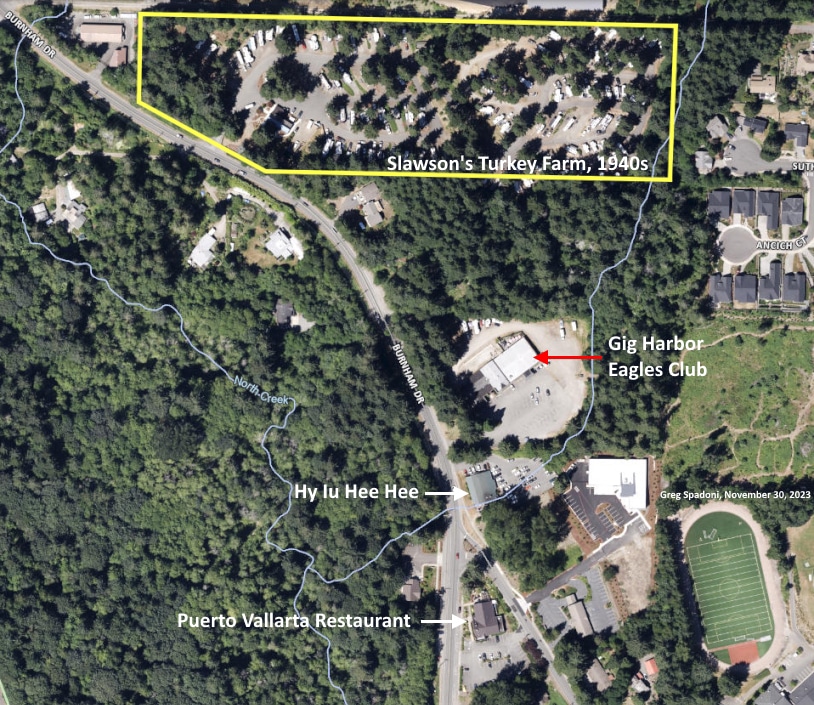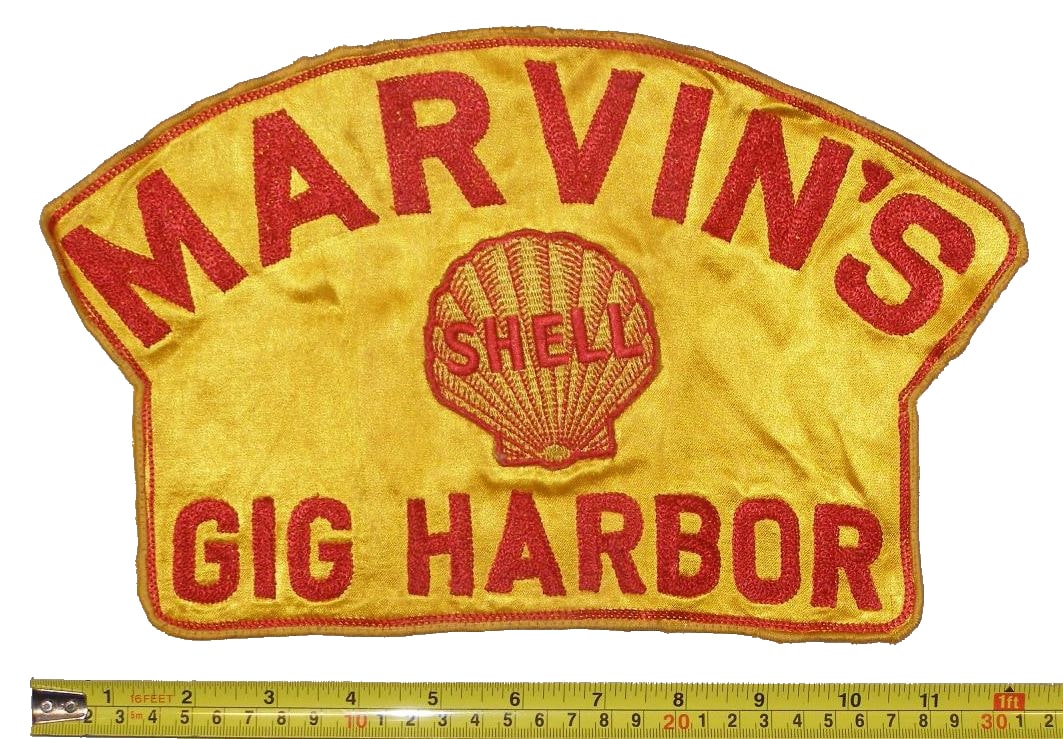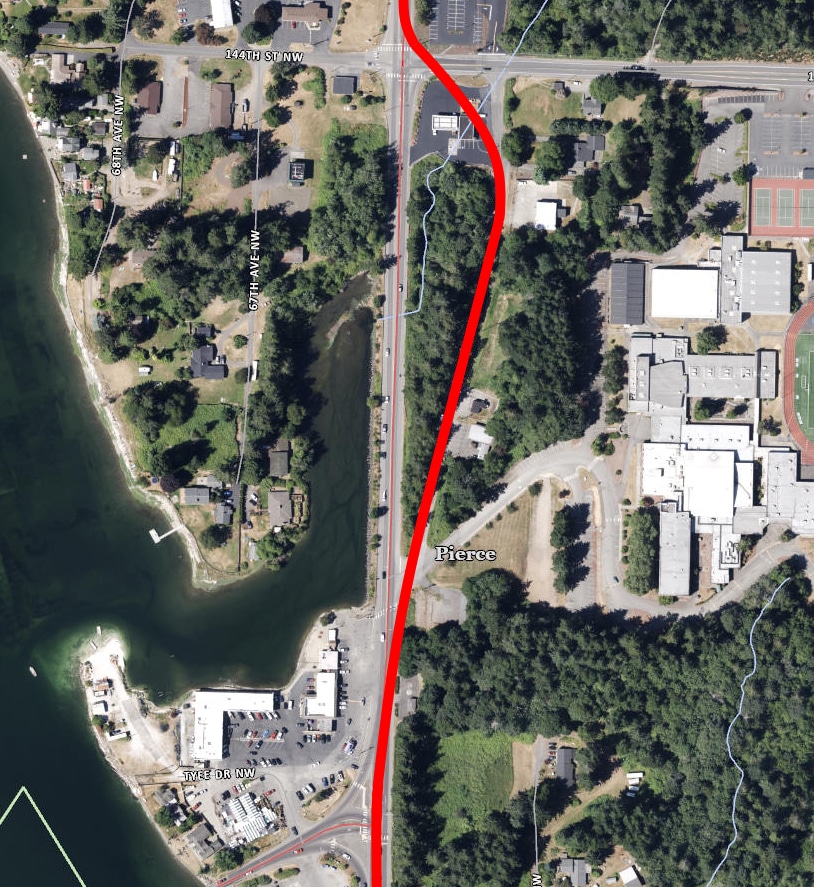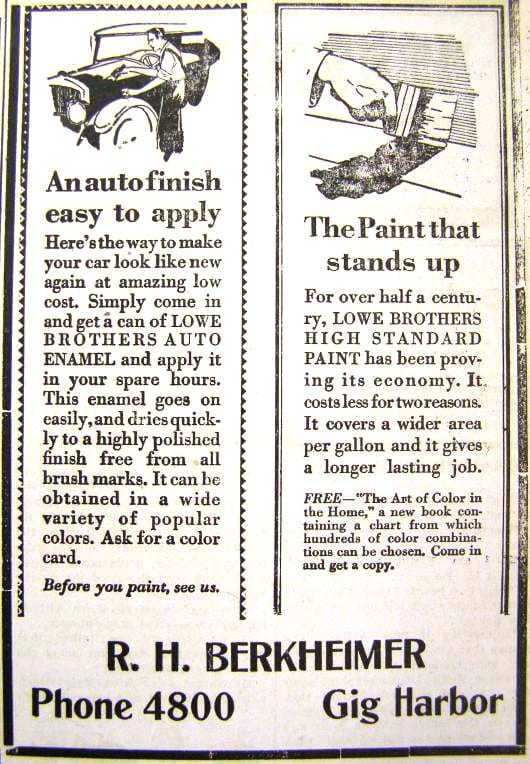Arts & Entertainment Community
Gig Harbor Now and Then: Here’s where locals got their turkeys in the 1940s
In a seasonal version of Gig Harbor Now and Then, our last question concerned a turkey farm on the Peninsula in the 1940s.
Arts & Entertainment Sponsor
Arts & Entertainment stories are made possible in part by the Gig Harbor Film Festival, a proud sponsor of Gig Harbor Now.
Question: Where was Slawson’s Turkey Farm located?
Answer: On Burnham Drive, on the very spot now occupied by Sun Outdoors Gig Harbor, a recreational vehicle park. Ellwel and Charlotte Slawson owned a couple acres on the opposite side of Burnham Drive as well.

Slawson’s Turkey Farm was on Burnham Drive in Gig Harbor, where the Sun Outdoors Gig Harbor RV park is today. Pierce County Assessor-Treasurer aerial base map.
It was a great location, as that portion of Burnham Drive was a state highway in the 1940s. It was the busiest road on the Peninsula.

In addition to turkeys, both young and mature, Slawson’s also sold turkey eggs for hatching. This advertisement from the April 12, 1946, Peninsula Gateway was found at the Harbor History Museum. (“One Mile North of Gig Harbor” was a general reference. The town had not yet been incorporated, so had no boundaries.)
Kenneth Leo Marvin
Because today’s answer and the new question are very short, we have room for something that may be of special interest to the oldest of Peninsula residents. We hope relative newcomers can appreciate it too, for it concerns a legendary figure in Gig Harbor history.
Kenny Marvin, who owned and operated a series of service stations in Gig Harbor, sponsored bowling teams at Gig Harbor’s first bowling alley in the early 1960s. That is believed to be the source of a recently discovered 12-inch-wide red and yellow “Marvin’s Shell Gig Harbor” patch.

Everything known about it points to this large patch having been on the back of Alfred Spadoni’s bowling shirt from the early 1960s. It will be donated to the Harbor History Museum shortly after this column is published. Photo by Greg Spadoni.
Mr. Marvin’s Shell service station was alongside what is now Highway 16, near where the Wollochet Drive overpass currently stands.
The city of Gig Harbor’s Kenneth Leo Marvin Veterans Memorial Park is named after him. His short biography on the city’s website does not begin to convey his uplifting personality or the toughness of his spirit that saw him through virtually all of World War 2 as a prisoner of the Japanese.
Gig Harbor Now and Then will likely mention Kenny Marvin in a future column. Having worked for him at his Chevron station on Pioneer Way, I had plenty of personal experience with Mr. Marvin, all of it good. And some of it very funny.
The Gig Harbor-Bremerton Highway
We have one short traffic detour to mention before we move on to the question of the week. In the past few months, while the new bridge over Purdy Creek was being built on Purdy Drive, traffic was rerouted over Purdy Lane, that oddly angled narrow road that goes behind the Chevron gas station at the southeast corner of Purdy Drive and 144th Street.
What purpose did Purdy Lane originally serve, and why was it built there, at that odd angle?
That is not the question of the week. It’s answered in the next paragraph, below the location map.

This red line shows the route of the original Gig Harbor-Bremerton Highway through Purdy. Pierce County Assessor-Treasurer aerial base map.
Purdy Lane was the route through Purdy of the original Gig Harbor–Bremerton Highway. (It was also known as the Gig Harbor-Port Orchard Highway, as the state road reached Bremerton through Port Orchard.)
Purdy Lane (as the Gig Harbor-Bremerton Highway) was built where it is simply because it was cheaper than going straight, where Purdy Drive does now. Going straight required a lot of road fill, which was difficult to move over a hundred years ago. Instead, the highway stayed on high ground that needed no fill, and crossed the creek where the Chevron gas station is today.
Berkheimer Hardware
Returning to the answer given on November 20, we discovered that Flamo, which first arrived in Gig Harbor in 1930, was a trade name of propane. We also learned that Flamo’s first appearance on the Peninsula was at Reuben Berkheimer’s store.
According to the June 26, 1931, Peninsula Gateway, the Berkheimer Hardware and Furniture Company sold hardware, furniture, paints, glass, dishes, kitchen ware, Easy washing machines, Monarch ranges, water pumping systems, Johns-Manville roofing, Johnson outboard motors, garden tools, bolts, pipe fittings, lawn and farm fencing, fishing tackle, Western Super-X ammunition, fishermens’ boots, and Spartan radios. And no doubt various other small items.

This advertisement for Berkheimer’s store is as true today as it was in 1931. If your car needs a new paint job, you don’t have to take it to an auto body shop. Just go to a hardware store and buy a can of paint and a brush. This ad, from the July 10, 1931, Peninsula Gateway, was found at the Harbor History Museum.
(A personal tip on painting cars by hand: It’s been my experience that it greatly speeds up the process by buying a broom instead of a brush.)
Today’s question flows naturally and smoothly from the Nov. 20 answer, if a couple weeks late. We now know what Flamo is, but where was the Berkheimer store?
That’s it. That’s the question of the week.
Where was Berkheimer’s store?
In a possibly (but probably not) helpful hint, we’re looking for the location of Berkheimer’s first Gig Harbor store. It opened in 1927.
We’ll have the answer on Dec. 18. Between now and then, feel free to visit the Gig Harbor Now Facebook page and note how many other people besides you aren’t offering a guess as to the location of Berkheimer’s store.
It’s probably pretty close to the number of people who don’t hear gobbling turkey ghosts when they pass by the old Slawson farm on Burnham Drive. Or at least don’t admit to it.
There are probably some who do hear them but are reluctant to talk about it. That’s understandable. It’s a difficult subject to broach. People might get the wrong idea if you volunteer that thousands of dead turkeys speak to you.
It’s likely to reduce the number of living people willing to associate with you. But if fewer social interactions is one of your goals in life, maybe an admission is worth a shot.
Greg Spadoni of Olalla has had more access to local history than most life-long residents. During 25 years in road construction working for the Spadoni Brothers, his first cousins, twice removed, he traveled to every corner of the Gig Harbor and Key Peninsulas, taking note of many abandoned buildings, overgrown farms, and roads that no longer had a destination. Through his current association with the Harbor History Museum in Gig Harbor as the unofficial Chief (and only) Assistant to Linda McCowen, the Museum’s primary photo archive volunteer, he regularly studies the area’s largest collection of visual history. Combined with the print history available at the Museum and online, he has uncovered countless stories of long-forgotten local people and events.

